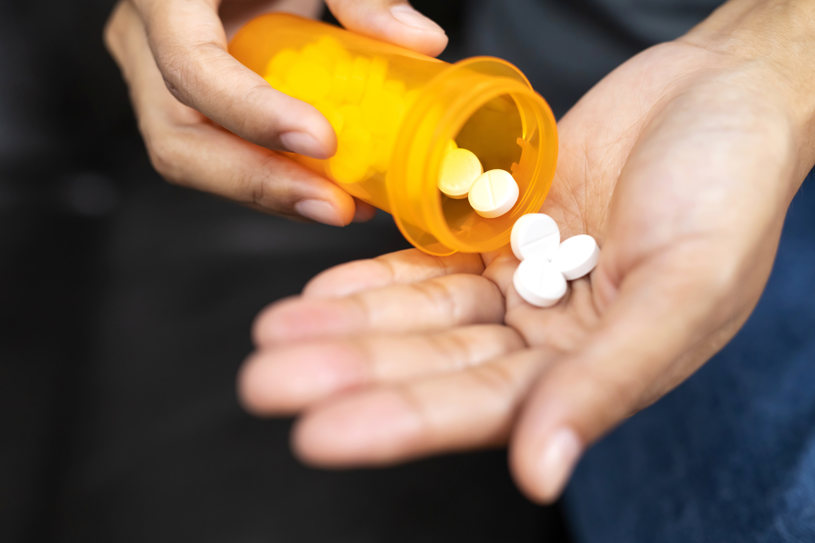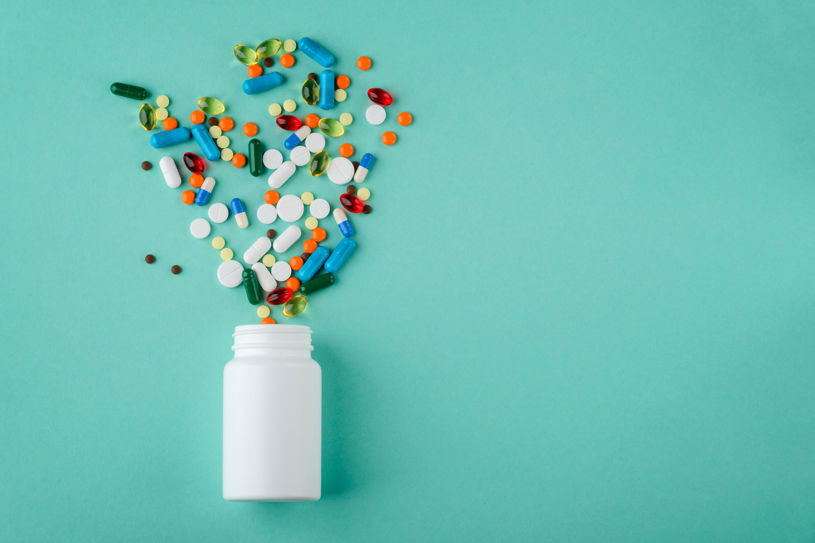Cyclobenzaprine, marketed with the brand name Flexeril, belongs to a drug class of central nervous system acting muscle relaxants. Cyclobenzaprine or Flexeril drug class is promoted primarily for prescription, short-term treatment of muscle spasms caused by acute, painful musculoskeletal ailments. Since its appearance on the pharmaceutical market in 1977, Flexeril use has increased, becoming one of the most frequently prescribed medications.
Table Of Contents:
- What Is Cyclobenzaprine?
- Cyclobenzaprine Brand And Generic Names
- Flexeril Dosage Forms And Strengths
- Flexeril Drug Class
- Indications for Flexeril Use And Risk of Addiction
- Who Is Most at Risk Of Cyclobenzaprine Addiction?
- Flexeril Abuse Statistics
- Symptoms Of Cyclobenzaprine Abuse
- Possible Dangers of Cyclobenzaprine Abuse
- Cyclobenzaprine Abuse Treatment Options

This article concentrates on the categorization of cyclobenzaprine, its mechanism of action in relief of muscle spasms, which demographic uses Flexeril medication the most, and the risks and treatment options for cyclobenzaprine addiction.
Recent research shows that prescription myorelaxant use, including the Flexeril pill, has doubled between 2005-2018. Hence, Cyclobenzaprine abuse and addiction bear a severe danger, especially for those who use this substance with higher dosages or for more extended periods than intended.
More About Muscle Relaxants:
What is Cyclobenzaprine?
Cyclobenzaprine (Flexeril) is a centrally acting muscle or myorelaxant. It is indicated as a short-term (2-3 week) adjunct treatment in addition to physical or occupational therapy for the relief of acute muscle spasms caused by local tissue trauma or sprains and strains.
Pharmacodynamics or the mechanism of its action is not fully clear, but it appears to act on supraspinal noradrenergic and serotonergic neurons, specifically at the level of locus coeruleus in the rostral pons of the brain stem. Through its actions, it inhibits efferent neuronal output to the spinal cord, depressing muscular conduction and thus preventing muscle spasm and the associated pain. Cyclobenzaprine, ordinarily prescribed as a Flexeril pill, is frequently used for the treatment of symptoms associated with lower back pain. Off-label use of Flexeril medication includes treatment of neuropathic pain of fibromyalgia, chronic non-cancer pain, temporomandibular disorder pain, and various other non-pain conditions. However, the Flexeril pill appears to be ineffectual in the treatment of muscle spasticity that results from spinal cord disease or pediatric cerebral palsy.

Cyclobenzaprine Brand And Generic Names
There are over 400 pharmaceutical companies that manufacture generic forms and over 15 companies that produce brand-name Cyclobenzaprine. Given below are some common generic and brand names:
- Cyclobenzaprine hydrochloride
- Flexeril
- Amrix
- Fexmid
- Mylan-Cyclobenzaprine
- Comfort Pac with Cyclobenzaprine
- Apo-Cyclobenzaprine
- Novo-Cycloprine
- Jamp-cyclobenzaprine
- Dom-cyclobenzaprine
Cyclobenzaprine is also available as a mixture of products used for stronger pain relief:
- Cyclo/Gaba 10/300 Pack containing Gabapentin
- NOpiod-TC containing Levomenthol, and Lidocaine
Flexeril Dosage Forms And Strengths
Cyclobenzaprine is offered in doses of 5 mg, 10 mg, 15 mg, and 30 mg, as well as in various formulations:
- Oral tablet
- Oral, film-coated tablet
- Oral extended-release capsule
Flexeril pill is five-sided and has two colors, depending on the dosage:
- The 10 mg pill is yellow in color. “Flexeril MSD 931” is engraved on it. It is contained in a white bottle with some yellow tints.
- The 5 mg pill is orange in color. The pill imprint is just “Flexeril.” It is also contained in a while bottle, with the brand name printed in blue.
Capsule forms of Flexeril are also available.
- The 30mg capsule of extended-release oral form is half blue and half red, with white text on the capsule.
- The 15mg capsule of extended-release oral form is orange, also with white text on the capsule.
Regardless it is currently not a controlled substance under The Controlled Substances Act (CSA), but it remains a prescription medication due to its excessive frequency of Cyclobenzaprine abuse and addiction.
Flexeril Drug Class
Cyclobenzaprine (Flexeril) is akin to a class of drugs, known as cyclical antidepressants. Cyclical antidepressants have been employed for the treatment of a wide array of conditions ranging from major depressive disorder(MDD), neuropathic pain, migraine, and attention deficit hyperactive (ADHD).
The most commonly known agents from Flexeril drug class are Tricyclic Antidepressants (TCAs). TCAs have been used to treat psychosis, mood disorders, and neuropathic pain. However, these drugs have wide adverse side effect profiles, a high likelihood for lethality and are, thus, prescribed cautiously. Cyclobenzaprine side effects, being part of this class of cyclical antidepressants, is no exception.

Indication For Flexeril Use And Risk of Addiction
Cyclobenzaprine is frequently prescribed to patients as part of a treatment regimen for acute musculoskeletal pain. The duration of its use is only for a brief period of time, usually a maximum of two to three weeks. The reasoning behind this rests upon studies that demonstrate that beyond two to three weeks, its use has no proven benefit. Thus, therapy should not be continued past this time frame. Furthermore, muscle relaxants like Flexeril are often prescribed along with opioids which increase the possibility of Cyclobenzaprine interactions, side effects and may even increase the likelihood of cyclobenzaprine addiction.
The risk of cyclobenzaprine addiction or dependence is quite low, and as such, it is not considered a Controlled Substance under the CSA. However, patients often acquire this medication without a prescription and continue to take it beyond the duration of prescribed treatment. These acts can be defined as Cyclobenzaprine abuse. According to the Drug Enforcement Administration, an 87% increase was observed from the years 2004 to 2011 in the number of Emergency room visits because of Flexeril medication abuse.
The Reasoning Why Flexeril Misuse Is So Frequent Can Possibly Be Attributed to Various Factors:
- Flexeril has a short window of effectiveness for the management of pain symptoms, and patients often develop a tolerance to its effects. With tolerance, the pain returns, and patients are often prompted to take increasingly higher doses of Flexeril to attain the desired effect.
- Flexeril medication is not a controlled substance and only requires a prescription. Patients often view prescription drugs as safer than illicit drugs. This makes prescription drugs, like the Flexeril pill, targets for abuse according to the National Institute on Drug Abuse (NIDA).
- Since Flexeril is a central nervous system acting substance related to Tricyclic Antidepressants, it is capable of producing sedation, anxiolysis, and hypnosis. These aforementioned effects can be heightened if Flexeril is combined with other CNS acting agents, such as benzodiazepines, barbiturates, opioids and alcohol. The combined effect of these agents together makes cyclobenzaprine abuse more likely to happen.
- Cyclobenzaprine can also produce hypnosis, anxiolysis, and feelings of euphoria. These effects increase the risk of potential recreational cyclobenzaprine abuse, especially by adolescents.
Who Is Most at Risk Of Cyclobenzaprine Addiction?
Similar to other substance use disorders, Cyclobenzaprine abuse alone or in combination with other substances can be predisposed to by the following risk factors:
- Family history of addiction and substance abuse
- Personal history of addiction and substance abuse
- Imitation of peers and peer pressure
- Coping with tensions or problems in the family such as neglect, marital discord, and job loss
- Coping with stigmatization in school or community
- As a form of acting out in adolescents
- Regular exposure to a social environment where substance abuse is accepted
According to the National Survey on Drug Use and Health(SAMHSA), around 25 million people ages 12 and up have abused prescription drugs like Flexeril. However, adolescents between the ages of 18 to 25 who obtain the drug from peers, relatives or buy it online comprise the most significant percentage of patients with cyclobenzaprine abuse problems. The alternative demographic of patients potentially at risk of cyclobenzaprine addiction and abuse includes older patients over 50 years of age. These patients often have authorized prescriptions for Flexeril medication for the management of acute musculoskeletal pain, but soon develop tolerance and subsequently take increasingly higher or more frequent doses or they continue to take the drug for a prolonged course as mentioned previously.
Cyclobenzaprine Abuse Statistics
Cyclobenzaprine, according to the Drug Enforcement Administration(DEA), has been available in the United States since 1977 and remains one of the most frequently prescribed substances. In 2011 over 25 million prescriptions were given out for Cyclobenzaprine, making it one of the most commonly prescribed medications for the management of musculoskeletal pain, in particular back pain.
Furthermore, in 2018 the Medical Expenditure Panel Survey (MEPS) reported that it was 43rd among the list of most frequently prescribed medications. In accordance with yet another report, an estimated 5.2 million people used this medication, with over 256,000 people having abused it at least once.

Signs and Symptoms Of Cyclobenzaprine Abuse And Addiction
Common signs and symptoms of Cyclobenzaprine addiction and abuse are nearly indistinguishable from other substance use disorders. They can be suspected when a maladaptive pattern of its use leads to clinically significant impairment or distress, as manifested by the following psychosocial, behavioral, and/or physical signs.
Psychosocial and Behavioral Signs
Patients who are addicted to Cyclobenzaprine and abuse it, manifest a set of recognizable signs and symptoms. Even though these signs and symptoms are not specific to only Flexeril addiction and/or abuse, their presence should raise suspicion and necessitate the need to ask questions and voice concerns.
- Cyclobenzaprine abuse harms the fulfillment of obligations at work, school, or home.
- Patients continue its use despite social or interpersonal problems caused or exacerbated by its effects.
- Patients lie or become anxious when their use of Flexeril is questioned.
- Important social, occupational, or recreational activities are given up or reduced by patients because of Cyclobenzaprine abuse.
- Patients either use Flexeril in more substantial amounts or for a more extended period than intended.
- Patients often have a persistent desire or unsuccessful efforts to cut down or control their use.
- Patients spend a great deal of time on activities necessary to obtain, use, or to recover from its effects.
- Patients have a craving or a strong desire to use Flexeril.
- Patients continue the use of Flexeril despite its adverse effects.
- Patients may steal or forge prescriptions to obtain Flexeril.
- A phenomenon of “Doctor Shopping” or visiting multiple doctors to obtain multiple prescriptions can be seen in patients with Cyclobenzaprine abuse or addiction.
- Patients often use Flexeril in situations in which it is physically hazardous to themselves, sometimes referred to as “risky use”.
- Patients continue the drug use despite physical or psychological problems caused by its use.
- Patients develop tolerance, exemplified by a need for markedly increased doses to attain the desired effects or by a markedly diminished effect with continued use of the same dose.
- Patients develop withdrawal, exemplified by the appearance of a substance-specific collection of symptoms following abrupt cessation or decreased Flexeril consumption.
Physical Signs
Physical signs of abuse or addiction reveal when the patient consumes increased dosages of the drug. These signs can include:
- Autonomic nervous system instability manifested by tremors, agitation, dizziness, vomiting, and increased heart rate.
- Slurred speech
- Mood swings
- Changes in sleeping patterns or habits
- Unexplained weight gain or loss
- Inability to think well
- Untidy appearance
Possible Dangers of Cyclobenzaprine Abuse
Cyclobenzaprine is safe for consumption as per the Food and Drug Association(FDA) when used as directed by a physician and for the appropriate duration. However, this drug can have serious and even life-threatening side effects if abused or used incorrectly.
Hypersensitivity or Allergy
Hypersensitivity or allergic reactions such as rash, urticaria, and even life-threatening anaphylaxis can occur in a subset of patients. In the elderly, especially when combined with other CSN acting agents like opioids, it can cause severe drowsiness and increases the risk of falls.
Overdose
The most severe consequence is overdose, which can frequently occur with abuse or when used in patients who have poor hepatic or renal health. Symptoms and signs of overdose are associated primarily with its anticholinergic properties, such as autonomic instability and CNS depression, linked to it being similar to Tricyclic Antidepressants. Furthermore, since this class of drug has a centrally acting inhibitory action, it should not be combined with other CNS depressant drugs, such as alcohol or benzodiazepines, as they have additive functions and can result in life-threatening cardiovascular or respiratory compromise. Learn more, how long does Flexeril stay in your system.
Withdrawals
Abrupt cessation or decreasing the dose taken in those patients who have been abusing this drug for a prolonged period of time is also dangerous, as this can provoke symptoms and signs of acute withdrawal such as progressively worsening flu-like symptoms.

Cyclobenzaprine Abuse Treatment Options
Acute management of overdose or severe withdrawal is complex and requires immediate contact of emergency medical services and the poison control center for immediate help. Typical management of acute overdose or withdrawal involves gastrointestinal decontamination, close cardiac monitoring, and monitoring for signs of central nervous system or respiratory depression.
Cyclobenzaprine addiction and abuse treatment are twofold. A three-month rehabilitation course offers a pathway to overcoming one’s addiction. A rehabilitation course provides two services.
- The first step is medically supervised “detox”, during which patients go through their withdrawal symptoms in a safe, comfortable, and controlled environment. This ensures that if any possible complications to the patient’s health arise, they can be promptly managed and alleviated with pharmaceuticals’ aid to promote rapid recovery.
- The second step involves various types of counseling, which encompass individual and group therapy, cognitive behavioral therapy, family therapy, life skill development, 12-step program, education concerning addiction and dependence, as well as development and implementation of relapse prevention strategies.
Patients can choose from:
- Residential Inpatient Drug Rehab programs offer live-in facilities that provide secure and drug-free residence settings and medical facilities within one location. Patients adhere to a day-to-day controlled schedule that encompasses various steps of counseling. This kind of program is indicated for people with intense addiction or those who have previously relapsed.
- Outpatient Drug Rehab programs are applicable to patients with no past medical history of substance use disorder. Participants in these programs meet several times during the week, and the program allows patients to have flexible schedules that permit time for school, work, or caring for one’s family.
Regardless of the kind of program chosen, after successfully completing therapy for Flexeril abuse and addiction, aftercare is necessary. Aftercare programs offer ongoing support for recovering addicts through regularly scheduled group sessions. During these sessions, patients can share their stories of trials, tribulations, and success on the road to recovery from Flexeril addiction in a safe and non-judgmental environment. Furthermore, patients can hear about recovery stories of other previous addicts as they work toward their goal of sustained and prolonged sobriety.
Hope Without Commitment
Find the best treatment options. Call our free and confidential helpline
Most private insurances accepted
Page Sources
- Abuse of Prescription (Rx) Drugs Affects Young Adults Most. (2021, January 11). National Institute on Drug Abuse. https://www.drugabuse.gov/drug-topics/trends-statistics/infographics/abuse-prescription-rx-drugs-affects-young-adults-most
- Summary of Misuse of Prescription Drugs. (2021, February 2). National Institute on Drug Abuse. https://www.drugabuse.gov/publications/research-reports/misuse-prescription-drugs/overview
- United States Food and Drug Association. (n.d.). FLEXERIL (CYCLOBENZAPRINE HCl) Tablets. Https://Www.Accessdata.Fda.Gov. Retrieved March 2021, from https://www.accessdata.fda.gov/drugsatfda_docs/label/2003/017821s045lbl.pdf
- Substance Abuse and Mental Health Services Administration, Drug Abuse Warning Network, 2011: National Estimates of Drug-Related Emergency Department Visits. HHS Publication No. (SMA) 13-4760, DAWN Series D-39. Rockville, MD: Substance Abuse and Mental Health Services Administration, 2013
- U.S. Department of Justice Drug Enforcement Administration Diversion Control Division. (2020, March). CYCLOBENZAPRINE (Brand Name: Flexeril®, Amrix®). Deadiversion.Usdoj.Gov. https://www.deadiversion.usdoj.gov/drug_chem_info/cyclobenzaprine.pdf
- Brunton, L., Knollmann, B., & Hilal-Dandan, R. (2017). Goodman and Gilman’s The Pharmacological Basis of Therapeutics, 13th Edition (13th ed.). McGraw-Hill Education / Medical
- Cyclobenzaprine | DrugBank Online. (n.d.). DrugBank. Retrieved March 2021, from https://go.drugbank.com/drugs/DB00924 Cyclobenzaprine. (2020, December). Drugs.Com. https://www.drugs.com/cyclobenzaprine.html
- Katzung, B., & Trevor, A. (2020). Basic and Clinical Pharmacology 15e (15th ed.). McGraw-Hill Education / Medical
- Soprano SE, Hennessy S, Bilker WB, Leonard CE. Assessment of Physician Prescribing of Muscle Relaxants in the United States, 2005-2016. JAMA Netw Open. 2020;3(6):e207664. doi:10.1001/jamanetworkopen

 Authored by
Authored by  Reviewed by
Reviewed by 

